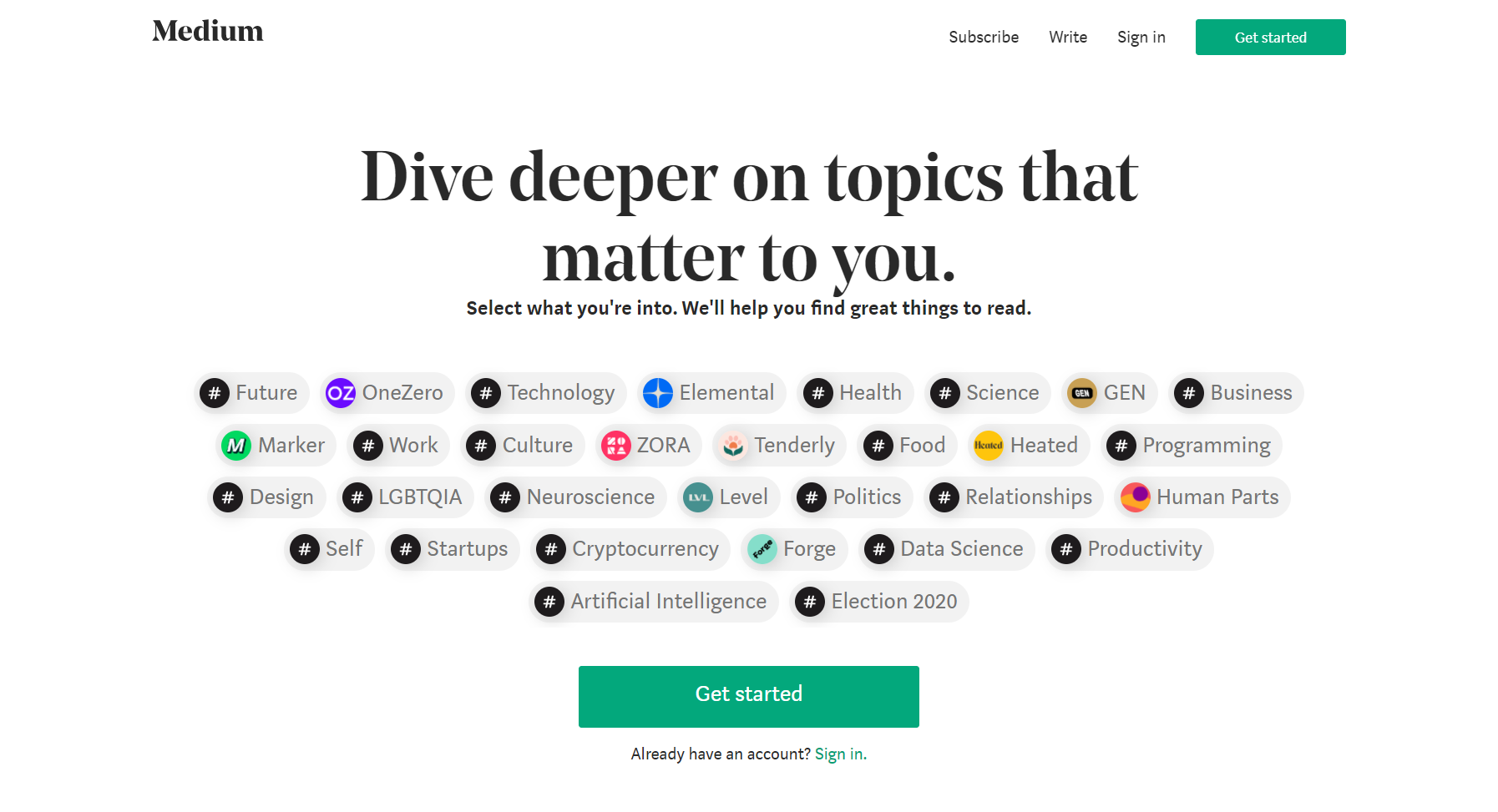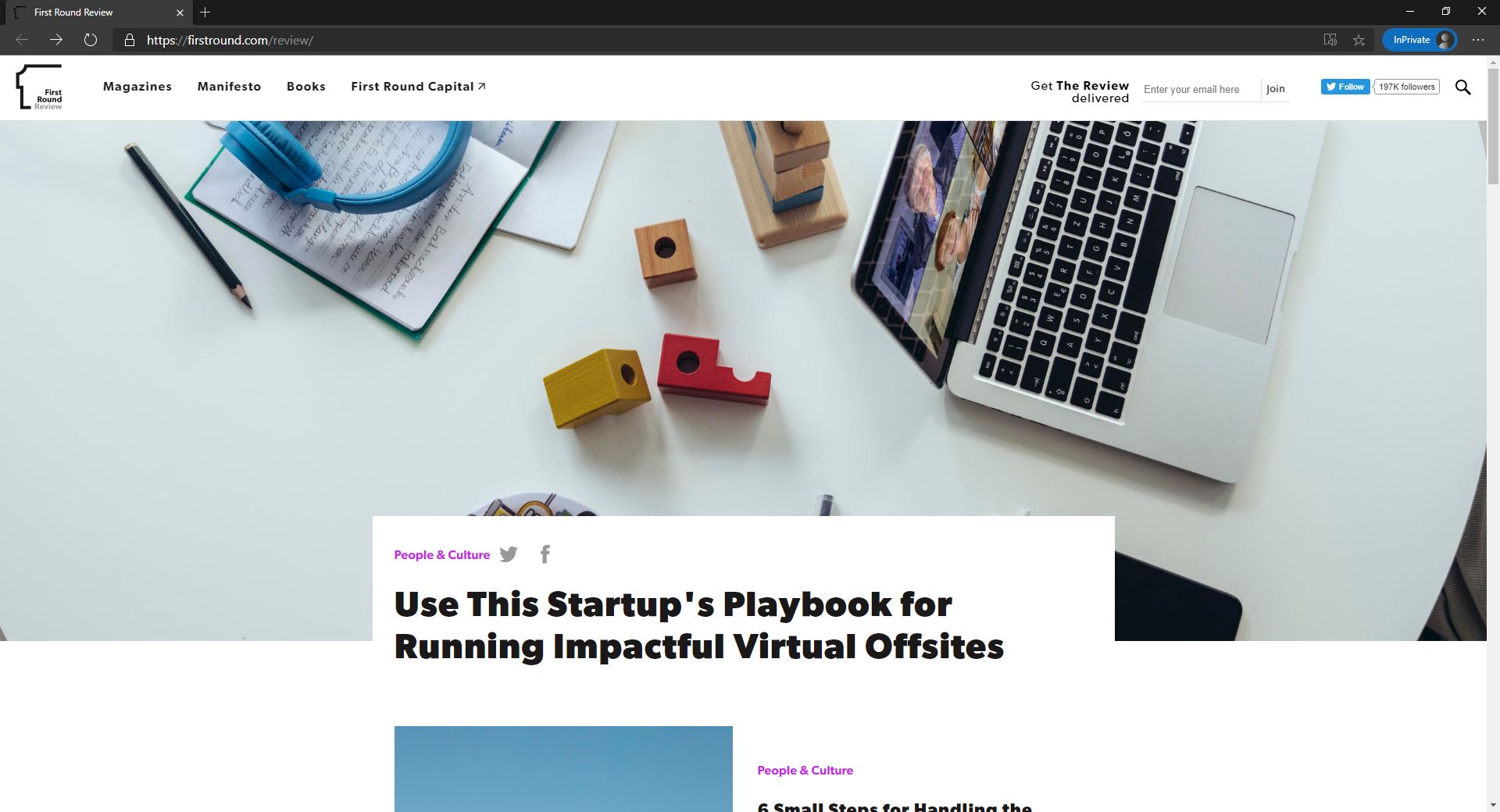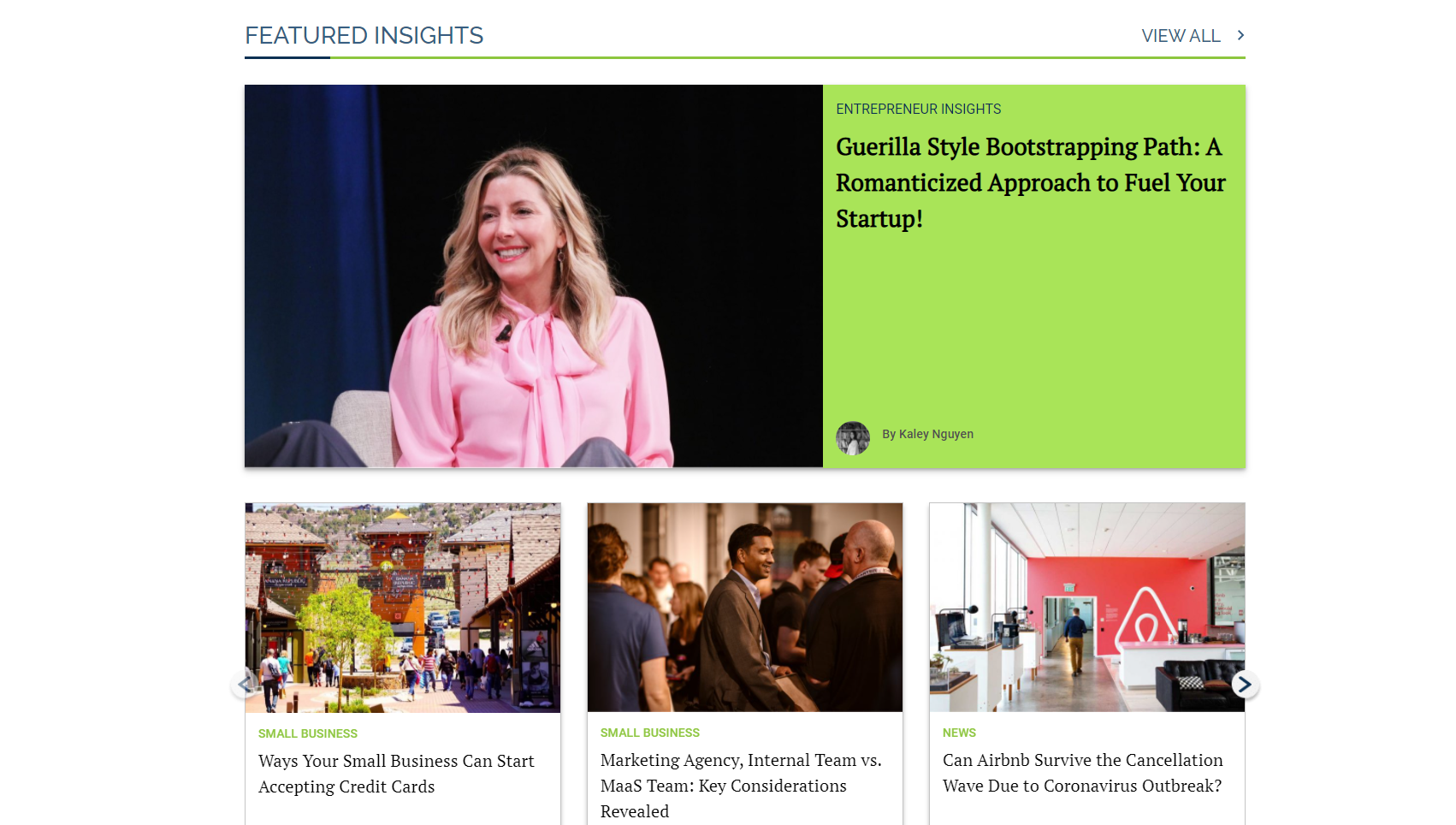It’s Time to Stop Blogging on Medium & Run Your Own Business Blogs!
Should you have been within the blogging sphere for a while, you must have heard of Medium as a content publishing behemoth, which picks up the reins from Blogger, WordPress.com, and Tumblr as the go-to spot for those who wish to quickly start a blog. If you have a voice, Medium claims to have room for it, no matter your background, “who you are”, “whom you know” or your choice of topic. This community blogging platform is the ultra-inclusive place to find content by everyone – from the former Vice President Joe Biden to actor Joseph Gordon-Levitt to even your college freshman cousin who reviews dance shows in her spare time.
Because of its massive growth, several businesses embracing the power of content marketing have built their blogs on Medium. Yet, in the end, from entrepreneurial standpoints, will this blogging approach be effective or do wonders for the bottom line of these businesses? Is it really worth cultivating a Medium presence? Unfortunately, the answer may be “not”.
There exist some notable drawbacks of this site, which business owners should take into close account and consider whether it’s time to stop blogging on Medium and orient your effort into establishing your own blogs instead.
What Exactly Medium Platform Bring to the Table?
Before delving into its downsides, let’s first take an objective view of what Medium exactly is as well as the reasons why this site becomes so popular within the blogging world.
To put it simply, Medium is an online publishing platform, which is host to a massive collection of articles written by amateur and professional writers alike. It is where readers can find insightful stories and articles on the topics that interest them. Plus, the platform is intended to let the bloggers or so-called “storytellers” find the right audience for whatever they have to say. Currently, some of the articles are hidden behind a paywall, which forces visitors to pay for an account. In this way, authors usually reach a smaller audience but make a larger profit.
Born out of the concept of Twitter by one of Twitter’s founders, Ev Williams in 2012, the blogging platform initially aimed to go beyond the 140-character limit of Twitter’s message, becoming where thoughtful and quality pieces of content could be posted and shared. Then, four years later, Medium introduced paywalled content (available only to subscribers) and began paying authors. As articles became more popular and received more “claps” – Medium’s version of “likes”, the authors earned more money. Given its popularity, Medium’s profits halted in late 2018, and since then, Williams has tried to raise more money for the platform.
Since its inception, Medium.com boasts that over 7.5 million posts have been published and that it’s its reader base has grown to 120 million unique readers. With such an extent of readership available, it begs the question of whether or not businesses should be publishing content on Medium as part of their content strategy?
When it comes to answering this question, on one side, there present a handful of undeniable advantages of adopting Medium as a blogging destination.
1. Aesthetically Pleasing & Clear Design
Nowadays, it’s somehow difficult to find a blog site that is just a clean webpage with the text clearly displayed in the main section, without any annoying advertisements that make reading difficult. Medium platform’s design is unique, intriguing, and very friendly for both readers and search engines.
2. Easy Start
Oneof itsnoteworthy plus points is such an ease of use that most contributors can start blogging on Medium in less than five minutes. You just have to create a new account and sign in, and then the brand new, shining text editor is ready for you. Since the interface is clean and intuitive, there is no worry over technical complexes – all you have to do is to craft an article, assign a proper category, and eventually hit the publish button.

3. Huge Audience Base
This seems to be the greatest appeal of Medium to business owners. Rather than building your blog audience from scratch, with Medium, you are allowed to put your content in front of the readers who are interested in a certain subject, by simply assigning the proper category or tags to your article. Additionally, as you build the number of followers who subscribe to your posts, you can probably gain exposure, funnel referral traffic to your site (by adding a subtle link or call-to-action at the end of your post), and also enhance your brand awareness.
It’s Time to Stop Blogging on Medium!
Despite those attractive merits, there exist good arguments why you, as a business owner, shouldn’t build your business’s blog on Medium. Even when you do not care too much about search traffic, it turns out to be terrible if you wish these Medium-based blogs to be a core part of your customer acquisition strategy.
Reason #1: You’re building Medium’s authority and traffic instead of yours
Obviously, Medium’s huge readership, amazing authority, along with high traffic are what draws most brands and authors to the platform. Yet, the hard fact is that Medium owns millions of visitors a month doesn’t necessarily mean that your blog will, too. Even when you can direct referral traffic to your own site, how many of those Medium visitors will come to your site articles as well? Perhaps around one percentage!
Furthermore, since you’re publishing content on a domain that’s not yours, you’re actually building SEO authority and backlinks for Medium, not for your site. What does that mean? It means that the next time people search for your brand name, they might find a Medium article at the top of the search results and they’ll end up on Medium instead of your own blog or website.
Notably, while it’s your hard work and fantastic pieces of content that drive part of Medium’s traffic, chances are that your competitors will be the ones who get to enjoy the results of your work instead of you.
Reason #2: You Don’t Own Your Content
The biggest problem with making Medium your primary blogging channel is that you don’t own your content – Medium does.
Should Medium decide to turn off their site, delete your articles, or for some reasons, ban your blog, there’s almost nothing you can do. Every word you wrote, all the time and effort you put into writing your articles and establishing your readership base – all of it may go in a blink of an eye and you can’t do or say anything about it because it’s not your platform. It’s theirs and their choice to keep it, take it offline, or make whatever changes or restrictions they please.
That may seem like a far-fetched and unlikely event, yet, when you see how Twitter, Instagram, YouTube as well as other social platforms regularly shut down accounts, you should not wish to put yourself at risk of that sudden de-platforming.
There is an article called “Why we left Medium, a cautionary tale” that described the experience of a once-Medium blogger and what might happen when you’re publishing content “on rented land.” And here some summary paragraphs from this:
“The Manage Comics blog was down for a number of days, with no notice to us, and we have no idea how or why. Worse is the fact that all of that organic traffic that we’ve built up over months to the blog, has all vanished. Our blog has all but disappeared from the online world, and now we have to build that traffic from the ground up.
During the two weeks that our blog was missing from the internet, Google delisted dozens of blog posts that were generating organic traffic for us. It took us a year to build up that traffic, we did significant outreach to comics press, released press releases, and were featured in a number of different places. All of those links have been delisted, and Google has no way to know that we are back and didn’t simply vanish.
The good news is that the year the blog was around on Medium gave the rest of our website some actual Google ranking, and now we’re starting to see some growth on the actual website, but the damage we are dealing with is huge and will take a long time to recover from.
We will not let this happen again (fool me once, shame on you, fool me twice, shame on me) last weekend I worked to bring the entire blog in-house, where it belongs, and it’s now happy as part of the whole info.managecomics.com website, which is a self-hosted WordPress website.
….
Because of the negative effects on our business, and Medium’s lack of a reasonable explanation for what happened, we have removed all content from Medium, and we are firmly advising our clients against using Medium as a blogging platform.”

Reason #3: You Have No A/B Testing and Metadata Control
Should you wish to get more advanced with your article targeting and test out different titles, descriptions, images, and preview snippets, then Medium is never an ideal choice – this publishing platform won’t let you do that either. More often than not, you will be stuck with what you have set as the title and what they pull as the snippet, limiting your ability to test and see what works well for improving click rate and attracting the audience.
Why does this matter? This obviously matters – adopting Medium, even the pros don’t know what will work best for getting more click-throughs, and sometimes you have to test a few of your best ideas to see what sticks. It might not be a problem when you’re just starting out, but as you grow your blog and aim to get more serious about it, this can turn into a major roadblock.
In addition to A/B testing, one of the most effective practices you can do for your SEO is to create custom meta titles and descriptions that will capture potential readers’ attention when they see your post in Google. However, should you make up your mind to publish on Medium, you won’t get any control over your metadata. They’re automatically generated for you, so if you want to make your post more attractive for search results, you’re out of luck.
After all, if SEO and site traffic is a critical “ingredient” of your content marketing strategy, then it’s time to stop blogging on Medium.
Reason #4: Your Articles May Suffer the Aggregator Penalty
Technically, Google prefers sites that have a high average quality for their pages, which is why deleting deadweight pages on your site, like old or shallow content, is amongst viable approaches to improve your site’s rankings. The problem with platforms like Medium is that every article published on Medium is under the “medium.com” domain, thereby there exist hundreds of thousands, if not millions, of other pages dragging down the average value of a Medium article.
Because of this massive amount of content, it’s tougher to have certain individual Medium pages highly ranked, since the per-page quality of a Medium article is deemed to be lower. Quite similar to Reddit, Pinterest, Twitter, and other media aggregators, this is the same reason you rarely see results from these sites at the top results on Google unless there are very few outstanding articles to show.
Reason #5: There’s a Lot of Competition for Attention
“Thanks to” the huge popularity of Medium as an online publishing platform, an increasing number of brands have started leveraging it. That means that, besides competing with other pages indexed on Google, you’re competing with other businesses and bloggers within the Medium platform itself, every single day.
On average, most visitors spend less than two minutes on Medium. So, chances are that they might just as easily read someone else’s story instead of yours, and then leave. Given that, crafting a blog on your own site turns out to be a much wiser option. Why? Since once a visitor lands on your blog, they’ll only have your posts to read – no other distractions or hundreds of other bloggers or articles to compete for their attention over there.

Reason #6: There are No Tracking Pixels
If you publish on Medium, of course, you cannot add any kind of custom embedded call to action – custom contact form, share buttons, product embeds, email pop-up, slide-in, or any other fancy feature you might include in your business’s blog – to persuade your audience to join your newsletter or trial your product. Not being able to have such calls to action in your articles wouldn’t be a big deal if you could add a tracking pixel to retarget your readers with ads.
But unfortunately, when blogging on Medium, you can’t, either!
To be more precise, Medium won’t allow you to add code to track your readers and advertise to them, further devaluing any article that you publish there. This makes sense from the point of view of their business: they don’t prefer tons of custom code breaking their site. Yet, from the perspective of businesses trying to leverage their blogs to generate sales, it ends up hurting you.
If you might want to do anything with your articles besides plugin text and pictures, then Medium is going to limit you in the long run. After all, it just isn’t built for a business blog.
Reason #7: You Have No Control Over Recommendations
Recommended articles are a great way to keep people reading the content on your site, and having a “Read This Next” recommended section at the bottom of your blogposts helps with SEO, dwell time, bounce rate, and just about everything you care about for ranking your articles. But, again, Medium doesn’t let you control what gets recommended!
Actually, most of the time, what gets recommended will be other people’s articles. So instead of your content sending readers to more of your content, it’s sending them to other writers on Medium – who may also be your competitors. Obviously, it’s a winning strategy for Medium – but not so great if you wish to keep a captive audience.
Why Don’t Running Your Own Blog and Ignite Your Business Online Presence?
Should you not care too much about SEO and still be satisfied with the limited features that Medium offers and the direction the platform, then there’s no need to change where you publish your articles. Nonetheless, if you’re thinking about capitalizing on your blogs or turning it into a truly profitable business, then it’s time to head to another solution that you can have full control over – running business blogs on your own website.
Starting and maintaining your own blogs can be a big undertaking. In addition to crafting stunning and value-based pieces of content, which also takes a considerable amount of time and effort, you may tackle countless irritating technical issues – expired SSL certificates, plugin conflicts, coding problems, malware, amongst tons of other things. Even you manage to pull it off, it will typically take a long time to form a huge readership and eventually drive sales to your business.

No matter how tough this may seem to be, running your own blogs is worth it in the long run. Compared to blogging your content on Medium, having your blogs published on your own site empowers you to exercise full control over its appearance and how content is presented. Below presents some of the most valuable advantages of this approach:
#1. You Build Traffic to Your Own Domain, Not Someone Else’s
Every stunning piece of content you publish will earn you blog traffic, not a third party’s; hence, all the effort you put into writing great content for your audience ultimately pays off for you and your business in the long run. Blogging on your own site, your content will get indexed by Google and you can earn authority and backlinks to your own blog pages.
#2. You Can Design Your Space as You Like
It’s hard to form a unique brand awareness when your blog looks just like any other blog. When you run your own blog, you are in full control of the design of your blog, which includes the theme as well as its functionality. As a blog runner, you can make it the most unique place on the whole internet as well as change it up whenever you want!
In particular, should you want to add various features to your blog or posts such as social media sharing icons, an email subscription box, or a special offer, just do whatever you prefer without having yourself restricted under some fixed frameworks.
#3. You Can View Critical Metrics and Figures
The user count is never enough to gauge the performance of a blog page, especially when it comes to businesses leveraging blog marketing to reach out to the target audience and drive sales. With your own solution, you are granted access to in-depth data and statistics that will empower you to obtain crystal-clear insights into where your visitors are coming from, which articles are the most popular, and which design or writing approaches generate the largest number of visits.
#4. Your Voice Is the Most Important
Rather than building on “rented land”, when you get a blog on your own domain, you own your land and everything on it. You can decide how you aim your blog to grow, which publications you would like to promote, how to build an audience around your company, and even how to convert your site traffic into cash.

#5. You can establish a genuine relationship with your audience
When people come to your blogs published on your own site, if they take keen interest in what you have to say, it’s easier to develop solid trust and long-term relationships with your readers. Gradually, via your value-driven content, you can entice them to subscribe to your mailing list and nurture them to the point of becoming your customers.
Beyond any doubt, that’s an extremely challenging goal to achieve on a platform like Medium where the audience isn’t yours but the platform’s – and they are also the ones building a relationship with their readers, not you.
#6. This is not an either-or concern
If you wish, you can completely blog on your own domain and also publish your blog posts on Medium to enjoy access to the platform’s huge audience base. In fact, Medium has an import tool that makes it easy to bring your blog content to its platform. Should you be concerned about duplicate content issues, there is no need to be. The import tool will add a rel=”canonical” tag to the Medium version, making sure that you won’t get penalized by Google for identical or duplicate content issues. This tag tells Google that the original source of content sits on your blog.
The Bottom Lines
Should you publish content on a popular blogging platform such as Medium with a considerably huge readership that reaches far beyond your sphere of influence? Or, should you run a blog on your own, relatively unknown or facing a stagnating readership domain, yet under your complete control and ownership? Some may opt for the first one, but for those who aim for long-term success, orienting efforts into crafting stunning blogs on their own site will be a smarter choice.
Besides compelling pieces of content on your site, your online presence is what you should pay the most attention to. Should you need any help with a dedicated team to get your business well exposed to the digital world, don’t hesitate to get an online presence manager.
You Might Also Like:









